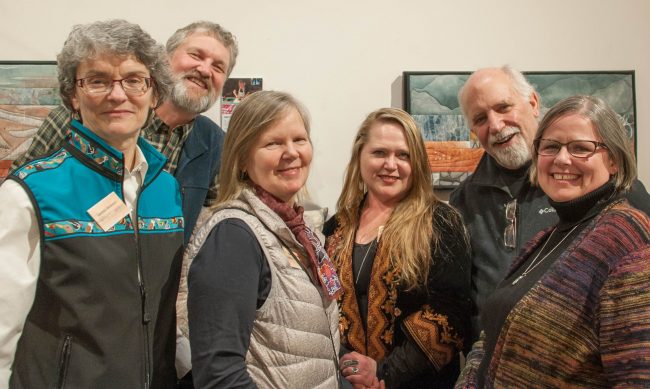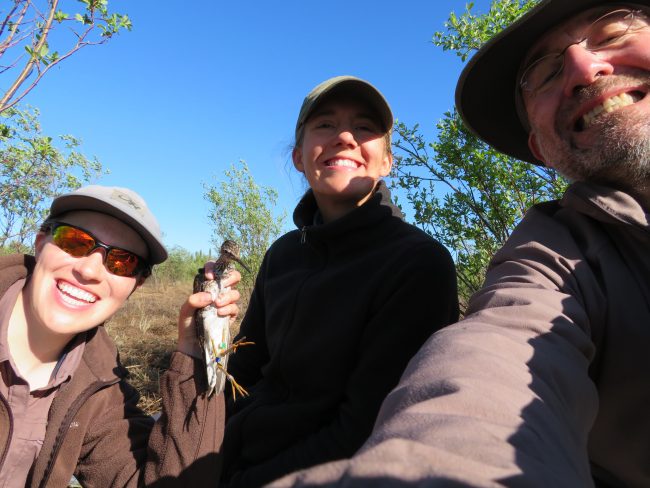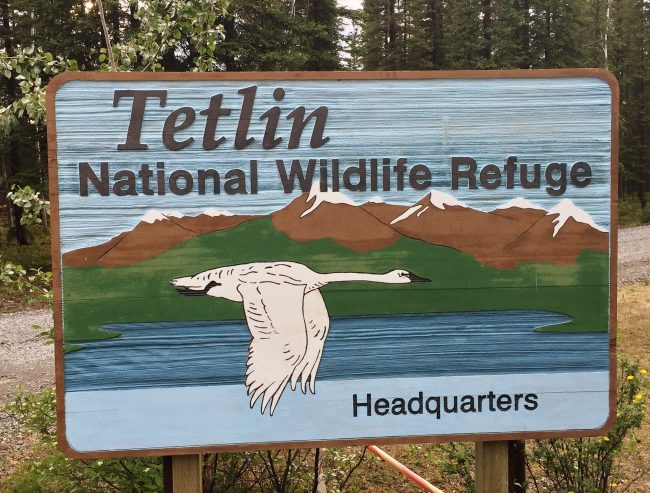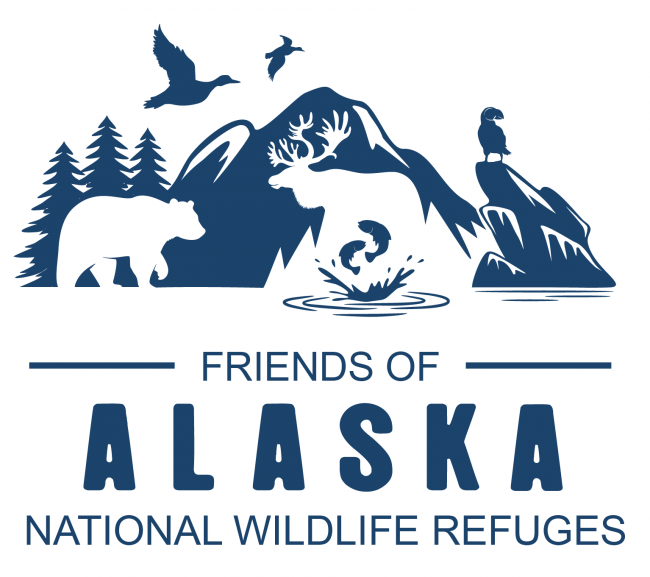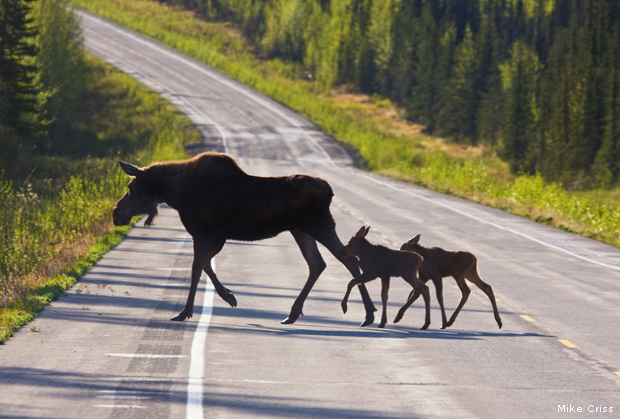The 5th annual Art in the Arctic, February 27, showcasing birds of the Arctic Refuges was a sparkling event well supported by Friends. Two of the six featured artists are Friends members – Laurel Devaney and Amy Mackinaw. Friends Patti Picha and Judy Williams worked the Friends Outreach table with Frank Williams photographing the event. 
Numbers were down some from last year with 125 attendees due probably to the biting cold but a good time was had by all. This is a great event for bringing in a diverse crowd and softly conveying refuge messages and information about the 200 bird species that use the northern refuges. This event is run by Fairbanks based refuges – Arctic, Yukon Flats and Kanuti. 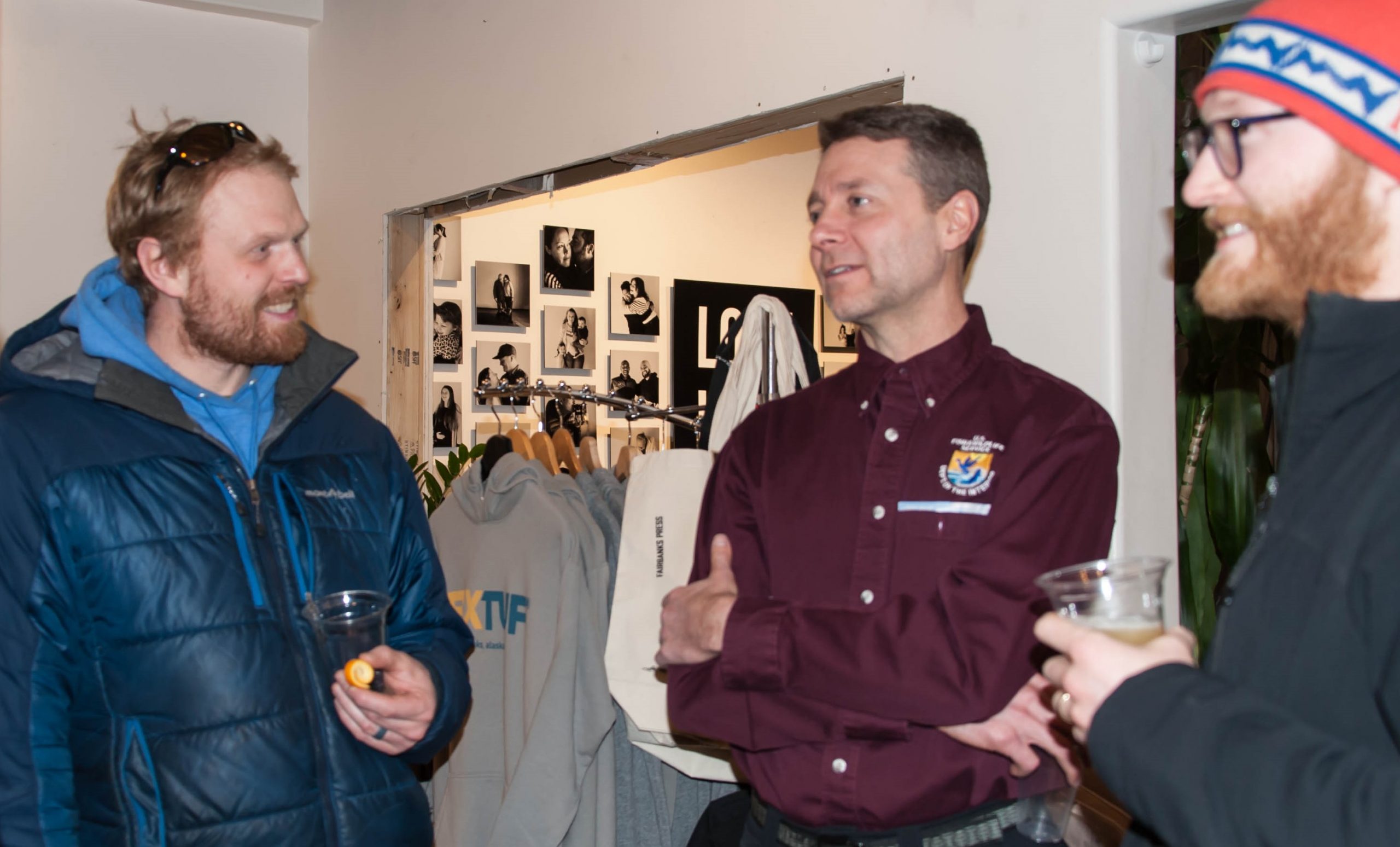
Two days later, Arctic Refuge’s 2019 Artist in Residence, Michael Boardman, gave a talk and led a drawing workshop for 14. Boardman has widely shared his experiences on the Arctic Refuge with over a dozen audiences both here in Alaska and in his home state of Maine. Kudos to the northern refuges for so effectively using art to broaden support and appreciation for wild lands and wildlife.
2020 March Advocacy Report
By: David Raskin, Friends President The Arctic Refuge drilling proposal and Izembek Refuge battles continue, and we expect major events in the very near future.
The Arctic Refuge drilling proposal and Izembek Refuge battles continue, and we expect major events in the very near future.
Arctic National Wildlife Refuge
The Secretary of Interior stated that the Record of Decision (ROD) is expected soon. Machinations continue behind the scenes regarding the amount of recoverable oil below the Coastal Plain. There are indications that the dry wells drilled in the past near the edges of the Coastal Plain may discourage the major oil companies from bidding on leases when the lease sale opens. That may open the door for smaller companies to buy leases at bargain basement prices. The Administration’s inflated projections for oil revenue from the Arctic oil seem more far-fetched as information dribbles out. Also, the USFWS announced a comment period on the excellent study on the potential impacts of seismic exploration on denning polar bears (federal register notice). Please send in your comments by April 20 and register your concerns about the dangers of seismic exploration to the denning of the endangered Beaufort population of polar bears,
Our conservation and Native Alaskan partners continue their highly successful outreach events throughout the country, and there have been many more great pieces in various media. The campaign’s meetings with executives of oil companies and financial institutions concerning the dangers of Arctic drilling and the financial risks of supporting such efforts continue to produce impressive results. Bernadette Demientieff, Executive Director of the Gwich’in Steering Committee, and the Arctic Refuge Defense Campaign (https://www.arcticrefugedefense.org) have succeeded in convincing most of the major banks and financiers to adopt policies against providing financing for oil and gas projects, with special attention to the Arctic. We continue to make progress in the decades-long battle to save and preserve the Arctic Refuge and its subsistence and cultural values!
Izembek National Wildlife Refuge
The federal defendants in our federal lawsuit to stop the land transfer and road filed their reply brief last week. It contains a rehash of most of the same arguments that the Federal Court rejected in our previously successful suit. Although we await a ruling from the Court, we are optimistic that we shall again prevail. We will provide updates as this lawsuit works its way through the legal process.
Kenai Predator Control and Hunting Regulations
The proposed Kenai Refuge predator control regulations still have not been released, but we continue to expect them soon. It is likely that the new regulations will not only allow hunting of brown bears over bait, as well as loosened restrictions on hunting in the Skilak Wildlife Recreation Area and 4-wheel drive access to frozen lakes, but we expect additional draconian measures to be included in the final version. It appears that there will be a 60-day comment period, but no public hearings. All of our conservation partners are closely monitoring this process and are preparing to take whatever action is necessary to stop this assault on Kenai Refuge wildlife.
Ambler Road
We are not aware of any significant development on the proposed 211-mile long Ambler industrial road even though it is on an “unprecedented, extreme fast track,” according to a BLM official.
Yellowlegs are noisy, but we’d sorely miss them if they disappear…
By Chris Harwood, Wildlife Biologist, Kanuti National Wildlife Refuge
I’ve conducted literally thousands of songbird surveys in my almost 30 years with Alaska Refuges. On Kanuti Refuge, the listening conditions at my survey count points are typically excellent—little to no wind and, of course, no car traffic. Really, the primary aural challenge is filtering out the species and individuals I’ve already identified and counted from possibly new ones.
In the boreal forest, however, there is one natural distraction that tests my ability to concentrate during surveys (and even tries my patience!). Songbird surveys in the Interior often coincide with late incubation, hatch, or brood rearing of Lesser Yellowlegs…and nothing can ruin a songbird survey quite like a Lesser Yellowlegs vociferously defending its nearby nest or chicks.
Breeding (especially, successfully hatching) yellowlegs have little competition where alarm-calling stamina (and volume) and defensive mobbing and distraction displays are concerned. Just try and hear that distant, soft-singing Blackpoll Warbler with a yellowlegs flitting in front of your face and screaming in your ear because you’re too close to its chicks you’ll never see.
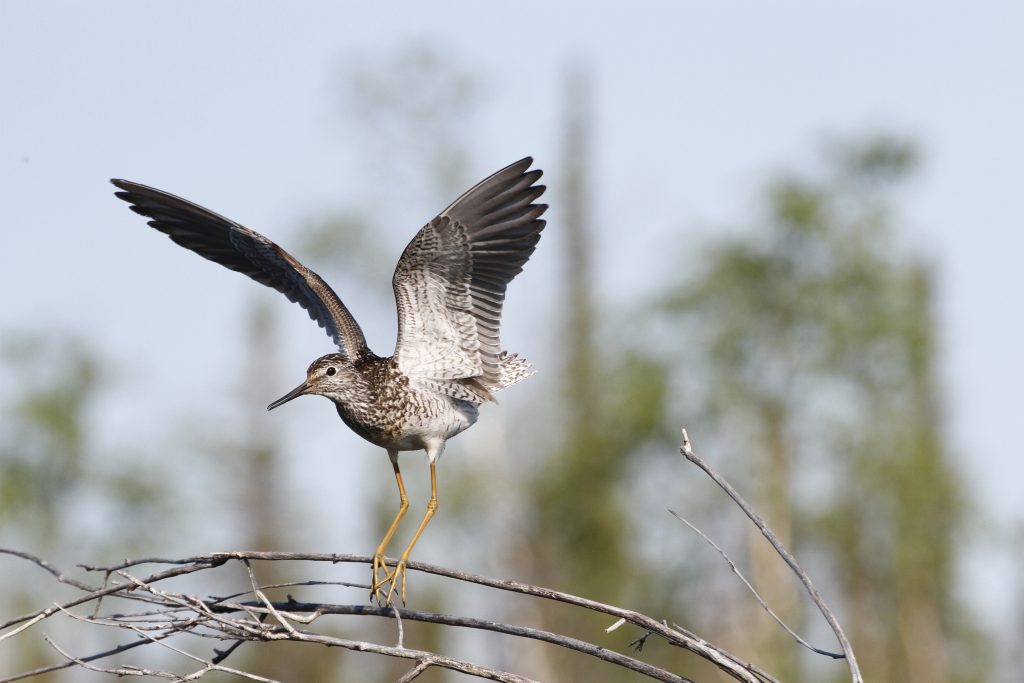
Well, it now seems that such survey distractions might be getting less common—and that’s not a good thing. The Lesser Yellowlegs population has declined by 70–80% over the past four decades across boreal North America. And it’s not just a Canadian yellowlegs problem. We believe Alaska yellowlegs are declining, too.
So, why the decline? Well, there’s a team of Alaskan and Canadian researchers who are now looking into threats to yellowlegs throughout their annual life cycle, including legal and illegal harvest in the tropics. Click here to read their report.
Through near-annual survey work from our administrative cabin along the Kanuti River, I have determined that Lesser Yellowlegs are still pretty common on a nearby study area. Given that this major yellowlegs research project lacked a study site in interior Alaska proper, I proposed that Kanuti Refuge join the boreal-wide “Yellowlegs Team” in 2018. So we purchased 10 GPS transmitters to track where some of our yellowlegs migrate and overwinter so possible threats along their annual route could be assessed.
We invited Laura McDuffie with USFWS Migratory Bird Management to the cabin in June 2019 to help us capture yellowlegs and deploy our transmitters (Laura’s M.S. thesis includes analysis of yellowlegs movements). The timing of Laura’s arrival was perfect—yellowlegs eggs started hatching that day!
We captured 13 adult yellowlegs over six exhausting days and marked them all with uniquely coded leg-flags (green with two white characters) and one blue band to denote them as “Kanuti” birds. Ten adults also received GPS transmitters. In the fall, we also contributed funding for the project’s genetics work.
Once they departed Kanuti Refuge, all but one of our 10 transmittered yellowlegs stopped initially and briefly on Yukon Flats Refuge before heading down the Central Flyway through the Great Plains of southern Canada. As of 20 August 2019, six of the yellowlegs had fanned out to points farther south, including Florida, Mexico, Cuba (2 birds), Ecuador and Peru. 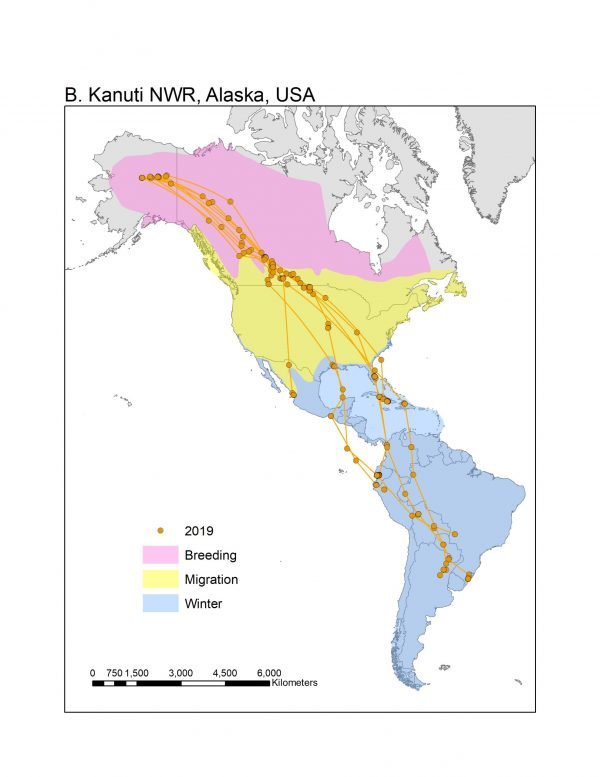
Four of the 10 transmitters were still reporting as of 1 January 2020. Two of our birds are wintering in southeastern Brazil, another in northeastern Argentina, and the fourth in western Mexico.
This spring, a field assistant and I will return to the cabin with the hope of re-sighting any of the birds marked last June. After hatch, we will also attempt to mark new birds as part of an ongoing effort to study adult survival. The Yellowlegs Team is currently assessing whether more transmitter work is needed in coming years.
Kanuti Refuge hopes to remain an integral member of this amazing continent-wide research partnership as we strive to better understand what it takes to ensure Lesser Yellowlegs remain common.
Meetings
Join us and learn more about refuges and wildlife at our meetings held from 5-6 pm AKT, the 3rd Tuesday of the month. from fall to spring. Every meeting can be attended live if you are in the same town as the speaker, at watch parties in Anchorage, Kenai and Homer or on zoom wherever you are. All meetings are also recorded and posted on this page. You do not need to be a member to attend.
Upcoming Schedule:
No December Meeting
January 20 – Robin West, retired Kenai refuge manager; Reflections from a solo canoe trip on the Upper Yukon; author of “Thirty of Forty in the 49th”, stories of his work as a biologist and manager on Alaska’s refuges.
February 17 – TBD
March 17 – TBD
April 21 – Aaron Lang, owner Wilderness Birding Adventures – Birding Alaska’s National Wildlife Refuges
Every meeting will feature an engaging speaker from one of Alaska’s 16 Refuges or a partner who is closely involved with our Refuges.
Tetlin Refuge’s Trumpeter Swans: A Comeback Story
By Poppy Benson
One of the delights of traveling on the Alaska Highway through the Tetlin National Wildlife Refuge is spotting graceful trumpeter swans on refuge lakes and ponds. The trumpeter, the largest waterfowl species in North America, is such an iconic Tetlin species that it was chosen for their logo used on their signs and publications. It is hard to believe that at one time, no trumpeter swans could be found on what was to become the Tetlin Refuge. 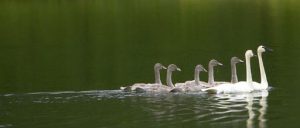
Trumpeter swans were nearly decimated from the United States for the skin and feather trade between 1600 and the 1800s. In 1935 only 69 individuals were known to exist in the US although others may have survived in remote parts of Alaska and Canada. No trumpeter swans were documented in the Upper Tanana Valley where the refuge is located until 1980. In 1985, the aerial swan survey recorded just 97 swans and 13 broods on and around the Tetlin National Wildlife Refuge. Since then the population has exploded. In 2015, the last swan survey, there were almost 2000 swans! This is consistent with swan recovery throughout the country. Nation-wide swan populations have increased exponentially at a rate of 6.2% per year between 1968 and 2010. Over half of North America’s trumpeter swans breed in Alaska.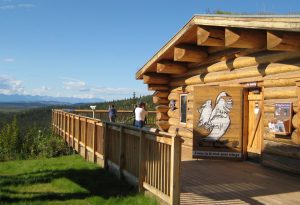
Will this growth continue or has the swan population on the refuge peaked or is it about to peak? The number of broods has been declining since it peaked at 147 in 2005. The 2015 survey found that a greater proportion of adult swans are not breeding successfully. Could all the available wetland breeding habitat already be occupied by swans? This year’s swan survey should help answer some of those questions. The data presented here is from “Thirty Years of Swan Surveys at Tetlin National Wildlife Refuge (1985-2015)” by Kristin DuBour. You can access it here.
2020 January Advocacy Report
By: David Raskin, Friends Board President
The Arctic Refuge drilling proposal continues front and center on the national stage, and the administration’s numerous assaults on the environment remain bogged down under the pressures of time, resources, and inadequate scientific studies!
Arctic National Wildlife Refuge
There is some news concerning DOI plans to sell leases for oil and gas development in the Coastal Plain of the Arctic Refuge. The Record of Decision (ROD) continues to be delayed for unannounced reasons and is now delayed until at least sometime in January. Since the lease sale had been planned for December 2019, the delay of the ROD and the necessary waiting periods after its release have pushed any possible lease sale farther into February at the earliest.
There is no word about plans for seismic exploration, which likely cannot occur before the 2020-21 winter, if at all. A recent report published in the Journal of Wildlife Management describes the potential impacts of various seismic scenarios. Even the most restrictive alternative would risk some polar bear mortality. So far, we have not seen a proposed plan for exploration. The warming arctic temperatures have narrowed the window of opportunity for such activities on frozen tundra. However, the State of Alaska appears to be moving forward with seismic exploration on State lands immediately adjacent to the Canning River in the Arctic Refuge.
Our conservation and Native Alaskan partners continue to hold successful outreach events throughout the country, and there have been many great pieces in various media. The campaign’s meetings with executives of oil companies and financial institutions concerning the dangers of Arctic drilling and the financial risks of supporting such efforts are producing impressive results. Bernadette Demientieff, Executive Director of the Gwich’in Steering Committee, is spearheading this campaign and has recently received national recognition for her great work. We will win this latest in the decades-long battle to save and preserve the Arctic Refuge and its subsistence and cultural values!
Izembek National Wildlife Refuge
There is no significant development in the suit filed on August 7, 2019 in federal district court that names Friends as the lead plaintiff along with eight conservation partners. We have not received a ruling from the Court, and we will provide updates as this lawsuit works its way through the legal process.
Kenai Predator Control and Hunting Regulations
The proposed Kenai Refuge predator control regulations have not been released, but we continue to expect them soon. It is likely that the new regulations will allow hunting of brown bears over bait, as well as loosened restrictions on hunting in the Skilak Wildlife Recreation Area and 4-wheel drive access to frozen lakes. It appears that there will be a 30-day comment period, but no public hearings. Recently, the State of Alaska and the Safari Club filed their motion for summary judgment challenging the Kenai National Wildlife Refuge’s rule that bans brown bear baiting (among other things). The Friends and other organizations are intervenors in this lawsuit and are closely following these developments. If the DOI adopts new predator guidelines, this lawsuit may be rendered moot.
Ambler Road
The has not been any significant development on the proposed 211-mile long Ambler industrial road even though it is on an “unprecedented, extreme fast track,” according to a BLM official. Trustees for Alaska assembled detailed, comprehensive comments on the DEIS that were submitted on behalf of numerous organizations, including Friends. We await information on the comments that were submitted and the issuance of a Final EIS. As with the many hurried and poorly supported BLM assaults on public lands, this process seems to have slowed.
Interested in Promoting an Alaskan Refuge?
Did you know that as a Friends member you have the opportunity to assist and promote a Refuge by participating as a Refuge Volunteer Liaison? We are actively seeking a few members who would enjoy working directly each month with a Refuge Manager and staff. The benefits of developing a personal relationship with a Refuge, learning about special programs as well as daily activities that make our Alaskan Refuges unique is a life-enhancing experience.
Liaisons in the past have been treated to personal tours of a Refuge, worked with biologists, environmental educators, visitor center staff and Refuge managers. For a monthly time commitment (ranging from 1-3 hours) a Refuge Liaison works with Refuge staff to 1) discuss Refuge news, projects, issues; 2) participates in identifying Refuge volunteer needs, funding, outreach assistance; 3) gathers information from the Refuge for newsletters, Facebook posts, blogs and membership meeting programs. The Refuge Volunteer Liaison will have the support of the Liaison and Membership Chairs for training, mentoring, and for assistance in submitting documentation such as brief monthly reports.
If you would like to learn more about the opportunity to serve as a Refuge Volunteer Liaison and to see if you might be match for one of our Refuges, please reach out to Betty or Sandy. We would be happy to share information and work with you to enhance and strengthen your ties with Friends of Alaska National Wildlife Refuges.
Come join us in our stewardship efforts!
Betty Siegel, Refuge Volunteer Liaison Chair siegelbetty@gmail.com
Sandy Kerns, Membership Chair sandra.kerns@alaskarefugefriends.org
Why Did the Moose Cross the Road?
Photo by: Mike Criss, National Wildlife Federation
Right through the middle of the Kenai National Wildlife Refuge runs the Sterling Highway – lifeline and only road to the communities of the Kenai Peninsula, plus the only access for Anchorites and tourists to the rich fishing streams, beaches, trails and other natural playgrounds of the Kenai Peninsula. Traffic in summer can be overwhelming with well over a million and a half vehicles a year. When wildlife crosses highways it is dangerous for people and wildlife – all wildlife. Moose, the most frequent victims, are as likely to die in vehicle collisions on Kenai Peninsula roads as to be harvested by hunters. Unlike in hunting, moose that die on the roads tend to be cows and calves needed to sustain the population.
Announcing Kachemak Bay Shorebird Festival Keynote Speakers for 2020


Catherine Hamilton is a professional artist, bird guide and conservationist. Her illustrations and writing can be found in The Warbler Guide and Good Birders Still Don’t Wear White, and in journals and magazines such as Nature, Living Bird, Bird Observer, and Orion Magazine. Catherine will share her work in her role as ZEISS Sports Optics’ Ambassador for Birding, working with partner organization Birdlife International to help promote conservation awareness through birding and art.
We hope you will join us May 7-10th at the Kachemak Bay Shorebird Festival to hear these two amazing folks speak.
2019 December Advocacy Report
By: David Raskin, Friends Board President
The Arctic Refuge drilling proposal continues to be front and center on the national stage, and the administration’s numerous assaults on the environment seem to be bogging down under the pressures of time, resources, and inadequate scientific studies!
Arctic National Wildlife Refuge
There is some news concerning DOI plans to sell leases for oil and gas development in the Coastal Plain of the Arctic Refuge. The Record of Decision (ROD) continues to be delayed for unannounced reasons and is now delayed until at least the end of the year. Since the lease sale had been planned for December 2019, the delay of the ROD and the necessary waiting periods after its release have pushed any possible lease sale into at least next February. The longer it takes to try to sell leases, the better.
There is no word about plans for seismic exploration, which likely cannot occur before the 2020-21 winter, if at all. However, the State of Alaska appears to be moving forward with seismic exploration on State lands immediately adjacent to the Arctic Refuge. Pam Miller sent the following useful information:
Public notice issued Dec 3 for public comment closing 4:30 pm, Jan 3, 2020 on the ADNR Geophysical Exploration Permit. The proposed survey start date given as Jan 10, 2020. The survey outlined in the application’s map shows it immediately west of the Arctic Refuge (official FWS) border of Arctic Refuge and it is described as “entirely on State lands.” This should be carefully checked against the legal descriptions for the survey. However, the application section G. lists the Canning and Staines Rivers as anadromous fish streams which may be crossed — yet the entirety of both these rivers are within the Arctic Refuge (FWS) boundaries. Clearly SAE 3-D seismic vehicles would be poised to quickly move into the Refuge if the IBLA ruled against the federal government in the pending border dispute. The permit application lists USFWS LOA for Polar Bear Incidental Take but it is not included here with the application, nor are other permits listed.
Our conservation and Native Alaskan partners continue to hold successful outreach events throughout the country, and there have been many great pieces in various media. The campaign’s meetings with executives of oil companies and financial institutions concerning the dangers of Arctic drilling and the financial risks of supporting such efforts are producing results. At least three major financial institutions have indicated they will not finance oil development in the Arctic. They seem to recognize the risks posed by the challenges of development in the Arctic and the obvious prospects that there will be a number of lawsuits to stop the leasing program. We will win this latest in the decades-long battle to save and preserve the Arctic Refuge and its subsistence and cultural values!
Izembek National Wildlife Refuge
There is no significant development in the August 7, 2019 suit filed in federal district court that names Friends as the lead plaintiff along with the previous eight conservation partners. We have not received any ruling from the Court, and we will provide updates as this lawsuit works its way through the legal process.
Kenai National Wildlife Refuge-Regulation Changes
The proposed Kenai Refuge predator control regulations have not been released, but we continue to expect them soon. It is likely that the new regulations will allow hunting of brown bears over bait, as well as loosened restrictions on hunting in the Skilak Wildlife Recreation Area and 4-wheel drive access to frozen lakes. It appears that there will be a 30-day comment period, but no public hearings. Friends and other organizations are closely following these developments and will take action at the appropriate time.
Kanuti and Selawik National Wildlife Refuges-Ambler Road
The proposed 211-mile long Ambler industrial road would skirt the north end of the Kanuti Refuge and cross streams feeding the Selawik Refuge. The Ambler Road is on an “unprecedented extreme fast track,” according to a BLM official. Trustees for Alaska assembled detailed, comprehensive comments on the DEIS that were submitted on behalf of numerous organizations, including Friends. We await information of the comments that were submitted and the issuance of a Final EIS. As with the many hurried and poorly supported BLM assaults on public lands, this process seems to be slowing down.
